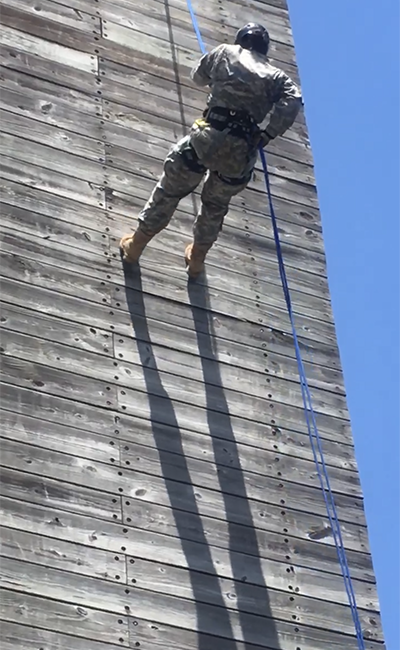Caroline found a new way to serve after spinal cord stimulation

Caroline had always dreamed of serving her country in the U.S. Army, so it was no surprise to anyone when, at age 17, she enrolled in a Junior Reserve Officers' Training Corp camp at Riverside Military Academy. Having almost completed her camp activities, she suddenly found herself in a great deal of pain and looking up at the eight-foot obstacle course wall from which she had just jumped.
While her pain was intense, hospital staff couldn’t find the source of her injury and sent her home with medication. This began a two-year journey of visits to orthopedists, neurologists, chiropractors, physiatrists and more trying to figure out the root of the problem, but never really getting any concrete answers.
In the meantime, her symptoms got infinitely worse.
“The pain was unbearable, and I felt isolated and defeated,” Caroline said. “There were times I would just lay in bed with my mom and cry.”
It wasn’t just the pain, though. Caroline struggled to maintain friendships and attend social events because of the pain. She also carried a lot of guilt because she looked “normal” on the outside and felt strangers judging her for using the mobility aids that helped her get around. “They couldn’t see my pain and had no idea all the medications I was on. It wasn’t fair.”
A chronic pain diagnosis – and a new approach
Finally, an interventional pain management specialist said she had complex regional pain syndrome – a form of chronic pain that can typically develop after an injury[1]. Caroline was relieved to finally have an official diagnosis.
After exploring a variety of clinical and holistic treatments with little improvement, Caroline and her care team decided it was time for a different approach. She began researching spinal cord stimulation (SCS), which helps manage chronic pain using mild electrical impulses to interrupt pain signals before they reach the brain, and decided to talk to her doctor about a trial implant.
During her trial period with SCS FAST™ Therapy, Caroline was impressed with her results. While experience may differ among patients, she experienced 85% improvement in her pain levels and was able to walk without the use of any mobility aids. She knew immediately that she wanted to move forward with the full implant.
“When someone has been living with chronic pain for an extended period of time, effective and immediate relief is imperative,” said Nilesh Patel, M.D., vice president of Medical Affairs, Boston Scientific, Neuromodulation. “Our FAST Therapy solution is designed to allow patients to experience significant relief from pain and within minutes[2].”
On the day of her procedure, Caroline wasn’t nervous at all. In fact, ever the dedicated chemistry student at Kennesaw State University in Georgia, she was submitting papers until about 20 minutes before she had to go in. While in the waiting room, she paused to reflect on all that she’d been through over the past four years and what it meant to be in this moment, getting the help she so desperately wanted and needed: “It was such an emotional moment for me.”
Pain relief through spinal cord stimulation
Now, at 21 years old and only two months out from her procedure, Caroline can walk better and farther, and without much assistance. She can even wear shoes and clothing that previously caused her extreme pain. “I’m amazed at how much this device is helping me,” she added.
Though she can no longer serve in the Army as originally planned, Caroline has found a new way to serve by pursuing a degree in pharmaceutical chemistry with the ultimate goal of helping patients.
“I’m so excited to get back to my life,” Caroline said. “I wouldn’t wish this whole experience on anyone, but I’ve learned so much along the way. I’m thinking of going to medical school and very much looking forward to walking across the stage at graduation without crutches and without pain.”
[1] Complex regional pain syndrome - Symptoms and causes. Mayo Clinic (accessed, December 2, 2022).
[2] FAST MOA computational modeling by Dr. Warren Grill’s lab at Duke University. Gilbert et al., Computational modeling predicts dorsal columns are involved in fast-acting sub-perception spinal cord stimulation (SCS). SFN 2021